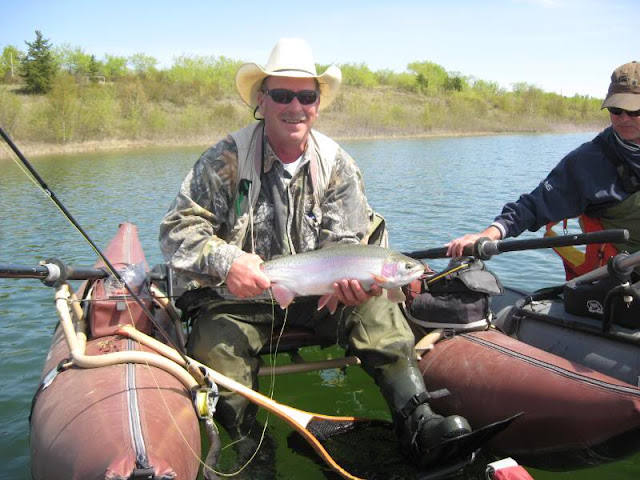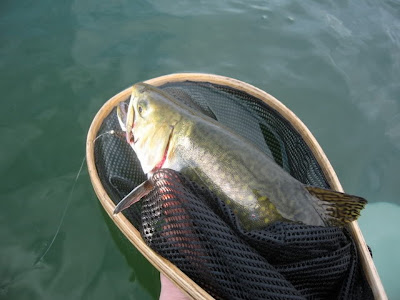Part II to fishing balanced flies dealing with setup and presentation.
 |
| A prime spring rainbow! |
Casting strike indicators coupled
with long leaders is a visual eye sore. There is no elegance about it. Weighted
patterns and in some instances added weight to the leader via split shot often
requires large open loops to reduce tangles. The name of the game is to
minimize false casting. Using the resistance between the fly line and the
surface tension of the water aids in loading the rod and ensures the fly line
will turn over. Longer fly rods of 9 feet or greater are preferred. Six and
seven weight lines will allow the indicator and fly to be picked up with
greater ease. The current line of choice amongst serious Stillwater fly fishers for this method is
hands down the Rio Indicator line. The thick front tip and short front taper
easily turn over the strike indicator.
 |
| A tiger trout that fell to a balanced leech in 30' of water. |
Balanced patterns can be fished with leaders
up to twenty five feet depending on at what depth the trout are feeding. In
most instances a leader of ten to fifteen feet will suffice. When asked what
size of tippet one should use the best answer is to let the conditions decide.
With patterns in sizes #6-10 3-4X fluorocarbon will handle most situations. As
patterns get smaller (#12 down), or in the case of clear water, 5X fluorocarbon
tippet may be required. Flies tied using the pin and bead method tend to spin
or “helicopter” during casting. This usually results in unwanted twisting in
the leader. Attaching a small #12 black barrel swivel between the end of the
leader and tippet material will correct this problem as well as aid in getting
patterns down quickly. It will also eliminate knot slippage between the
monofilament leader and fluorocarbon tippet.
A major factor in increasing the effects of
the balanced fly is the proper leader to fly connection. A standard clinch knot
draws life from the fly and reduces its animation in the water. Used in conjunction with a Non Slip or Duncan loop for the leader to
fly connection the balanced fly can come to life with minimal surface chop.A good illustration of a non-slip knot can be found here: http://swittersb.wordpress.com/2009/08/29/loop-knot-for-streamers-nymphs-non-slip-mono-knot/
Presentation
Balanced patterns can be fished
throughout the open water season with success. Starting in spring, when trout
patrol the shoals and littoral zones of lakes, hanging balanced leech patterns
below a strike indicator is an effective method to entice some of the lakes
largest specimens. At this time of the year water temperatures and oxygen
levels are ideal for trout in shallow zones of the lake. As the season
progresses and the water warms, trout will seek more suitable temperatures and
oxygen levels in deeper water where permitted. During this time, fish can still
be taken with balanced imitations below a strike indicator. As the water cools in the fall trout return
once again to the shoals and littoral zone and can offer exceptional late
season fishing with leeches, scuds, bloodworms and smaller damselfly and
dragonfly imitations fished below an indicator. At any time during the season
it is a good strategy to focus around weed beds both shallow and deep as well
as any structure such as sunken islands or points. Trout will often key in on
the array of forage in these areas which offer prime habitat for a variety of
both invertebrates and minnow species. Like with any form of fly fishing, matching
ones patterns to what is on the trout’s menu is a sure fire way to be rewarded.
Close inspection around the lake shore for recently hatched insects and on the
water for shucks will aid in pattern selection. It is this initial observation
that can often determine whether one has a boom or bust day on the water.
 |
| A fine Maligne Lake rainbow taken on a balanced pattern. |
Generally flies should be fished
within one to two feet of the lake bottom. To determine this, the easiest
method is to attach a pair of hemostats to the fly, which is attached to the
leader, and lower it until it hits bottom. By raising the fly/ hemostats off
the bottom the fly fisher can accurately determine where to attach the strike
indicator. The most effective strike indicators for this method are those of
the quick release variety as they allow easy adjustment when changing depths.
Always be observant of bottom type
and or the presence of macrophytic growth (weeds) and debris. Sometimes it is a
good idea to fish amongst weeds such as lily pads and openings in pond weed as
trout themselves cruise under cover in search of food. When fishing over Chara
mats make sure your fly is clear of the vegetation as your pattern will go
unnoticed.
 |
| Another quality Saskatchewan Bow'. |
As with chironomid fishing an
anchored platform offers the easiest and most precise way to cover water effectively.
When fishing from a boat a double anchor system is indispensable in reducing
side to side drift. If fishing from a pontoon boat or belly boat, a single
anchor in conjunction with the use of fins will allow proper boat control (you
can still mount a second anchor if you choose). Quartering casts with the wind is
the most effective way to cover water using the indicator and fly. The wind not
only provides animation to the fly but slowly allows the indicator to move with
it, dragging the fly along in the strike zone. Balanced patterns imitating
caddis pupa and mayfly nymphs are extremely effective in mimicking these
species near the lake bottom as they stage just prior to a major emergence. The
quartered cast method is ideal for covering water during such times. Once the
line has blown straight down from the anchored boat “popping” the indicator
back with short 2-3 inch strips will prolong the presentation. More often than
not this is the only way to present balanced flies on calm windless days.
 |
| "Popping" balanced flies can pay off under calm conditions. |
Fishing balanced patterns static
under a strike indicator is an effective and enjoyable method of Stillwater fly-fishing.
By applying these patterns (see previous
article) and techniques the beginner and advanced fly fisher alike will add
another tool to their arsenal in unlocking the world of Stillwater trout.












